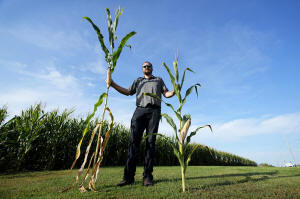‘Short corn’ could replace the towering cornfields steamrolled by a
changing climate
 Send a link to a friend
Send a link to a friend
 [September 24, 2024] By
SCOTT McFETRIDGE [September 24, 2024] By
SCOTT McFETRIDGE
WYOMING, Iowa (AP) — Taking a late-summer country drive in the Midwest
means venturing into the corn zone, snaking between 12-foot-tall green,
leafy walls that seem to block out nearly everything other than the sun
and an occasional water tower.
The skyscraper-like corn is a part of rural America as much as cavernous
red barns and placid cows.
But soon, that towering corn might become a miniature of its former
self, replaced by stalks only half as tall as the green giants that have
dominated fields for so long.
“As you drive across the Midwest, maybe in the next seven, eight, 10
years, you're going to see a lot of this out there,” said Cameron
Sorgenfrey, an eastern Iowa farmer who has been growing newly developed
short corn for several years, sometimes prompting puzzled looks from
neighboring farmers. “I think this is going to change agriculture in the
Midwest."
The short corn developed by Bayer Crop Science is being tested on about
30,000 acres (12,141 hectares) in the Midwest with the promise of
offering farmers a variety that can withstand powerful windstorms that
could become more frequent due to climate change. The corn's smaller
stature and sturdier base enable it to withstand winds of up to 50 mph —
researchers hover over fields with a helicopter to see how the plants
handle the wind.

The smaller plants also let farmers plant at greater density, so they
can grow more corn on the same amount of land, increasing their profits.
That is especially helpful as farmers have endured several years of low
prices that are forecast to continue.
The smaller stalks could also lead to less water use at a time of
growing drought concerns.
U.S. farmers grow corn on about 90 million acres (36 million hectares)
each year, usually making it the nation's largest crop, so it's hard to
overstate the importance of a potential large-scale shift to
smaller-stature corn, said Dior Kelley, an assistant professor at Iowa
State University who is researching different paths for growing shorter
corn. Last year, U.S. farmers grew more than 400 tons (363 metric tonnes)
of corn, most of which was used for animal feed, the fuel additive
ethanol, or exported to other countries.
“It is huge. It's a big, fundamental shift,” Kelley said.

[to top of second column] |

Cameron Sorgenfrey holds a tall corn stalk next to a short corn
stalk along one of his fields, Monday, Sept. 16, 2024, in Wyoming,
Iowa. (AP Photo/Charlie Neibergall)
 Researchers have long focused on
developing plants that could grow the most corn but recently there
has been equal emphasis on other traits, such as making the plant
more drought-tolerant or able to withstand high temperatures.
Although there already were efforts to grow shorter corn, the demand
for innovations by private companies such as Bayer and academic
scientists soared after an intense windstorm — called a derecho —
plowed through the Midwest in August 2020.
The storm killed four people and caused $11 billion in damage, with
the greatest destruction in a wide strip of eastern Iowa, where
winds exceeded 100 mph. In cities such as Cedar Rapids, the wind
toppled thousands of trees but the damage to a corn crop only weeks
from harvest was especially stunning.
“It looked like someone had come through with a machete and cut all
of our corn down,” Kelley said.
Or as Sorgenfrey, the Iowa farmer who endured the derecho put it,
“Most of my corn looked like it had been steamrolled.”
Although Kelley is excited about the potential of short corn, she
said farmers need to be aware that cobs that grow closer to the soil
could be more vulnerable to diseases or mold. Short plants also
could be susceptible to a problem called lodging, when the corn
tilts over after something like a heavy rain and then grows along
the ground, Kelley said.
Brian Leake, a Bayer spokesman, said the company has been developing
short corn for more than 20 years. Other companies such as Stine
Seed and Corteva also have been working for a decade or longer to
offer short-corn varieties.
While the big goal has been developing corn that can withstand high
winds, researchers also note that a shorter stalk makes it easier
for farmers to get into fields with equipment for tasks such as
spreading fungicide or seeding the ground with a future cover crop.
Bayer expects to ramp up its production in 2027, and Leake said he
hopes that by later in this decade, farmers will be growing short
corn everywhere.
“We see the opportunity of this being the new normal across both the
U.S. and other parts of the world,” he said.
All contents © copyright 2024 Associated Press. All rights reserved |